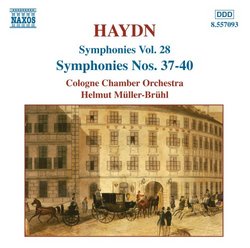| All Artists: Franz Joseph Haydn, Helmut Müller-Brühl, Cologne Chamber Orchestra Title: Haydn: Symphonies Nos. 37 - 40 Members Wishing: 0 Total Copies: 0 Label: Naxos Release Date: 3/22/2005 Genre: Classical Styles: Historical Periods, Classical (c.1770-1830), Symphonies Number of Discs: 1 SwapaCD Credits: 1 UPC: 747313209323 |
Search - Franz Joseph Haydn, Helmut Müller-Brühl, Cologne Chamber Orchestra :: Haydn: Symphonies Nos. 37 - 40
 | Franz Joseph Haydn, Helmut Müller-Brühl, Cologne Chamber Orchestra Haydn: Symphonies Nos. 37 - 40 Genre: Classical
|
Larger Image |
CD Details |
CD ReviewsExploring the Haydn Symphonies -- No. 37 -- 40 Robin Friedman | Washington, D.C. United States | 02/21/2006 (4 out of 5 stars) "In 1896, Johannes Brahms said the following about his celebrated predecessor: "People today understand practically nothing about Haydn any more. No one really considers that we now live in a time where exactly 100 years ago -- Haydn created all our music, where he gave one symphony after another to the world. ... What a man: beside him we are just wretches."
This CD, part of an ongoing project on Naxos of recording Haydn's symphonic output, includes four early examples of the "one symphony after another" that Brahms noted Haydn gave to the world. Naxos uses a variety of conducters and chamber ensembles in its project. For this CD, consisting of Haydn symphonies, nos. 37 -- 40, Helmut Muller-Bruhl conducts the Cologne Chamber Orchestra. Although consecutively numbered, these symphonies show different compositional styles and were composed at different times early in Haydn's career. They are lightly scored for strings, horn, oboe, and harpsichord continuo. Each of these works is in four movements. The earliest of these symphonies, no. 37 in C major, may well be Haydn's first effort in the form. There is a manuscript of it dating from 1758. But Haydn substantially revised it at a later date to include trumpets and tympani, accounting for its relatively high number in the standard list of his symphonies. This is a "fanfare" ceremonial symphony as are of its counterparts in the key of C major. It opens with an attention-getting flourish in the tympani and continues in a march-like powerful character throughout the first movement. The second movement in this symphony is the minuet which continues the tone of the opening but with a surprisingly reflective, lyrical minor-key interlude in the trio. The slow movement, for strings alone, also is in the minor key. The finale returns to the fanfare and pomp of the opening movement. The symphony no. 38 in C major, composed in 1768, is also in a ceremonial mode in its opening movement and in the following andante. These movements are somewhat more lyrical and relaxed than those of the earlier work. In the third and fourth movements, Haydn takes the symphony in a different direction by introducing extensive solo passages for the oboe. The solo oboe is introduced in the trio of the third movement and assumes a prominent role in the entire finale. The work was written for a famous virtuoso on the oboe who was visiting Esterhazy. Why Haydn did not use the oboe solo throughout the work is unknown. Symphony no. 39 in G-minor is sometimes referred to as the 'little G minor" to link it to and distinguish if from Mozart's symphony no. 40 in this key. The outer movements of this symphony illustrate a style sometimes referred to as Haydn's "sturm und drang." The first movement remains firmly rooted in G minor and is based upon a driving repeated theme broken by dramatic pauses -- which appear each time at a different place in the theme -- before the music breaks out in a long, passionate line. The second movement, an andante, is in triplets and a walking tempo. It is in marked contrast to the opening and is relaxed in tone. The minuet begins in a somber minor mode, but it is soon followed by a trio given to the winds with an oom-pah-pah accompaniment figure. The finale reverts to the intense, tragic character of the opening with a passionate, quick theme and a moving passage for strings alone just before the conclusion. The final work in this collection, the symphony no. 40 in F major, is a polished, tightly written work for small orchestra. As does much of Haydn, it combines the popular galant style of the day with learning, in the form of the quick fugal finale. The opening two movements feature two-part writing with elegant themes for the high strings juxtaposed against a walking accompaniment figure in the lower strings. The first movement has an elegant character while the second movement swings gently at, in this recording, an uptempo pace. The charming, light minuet features wind solos in the trio and the symphony concludes, as I mentioned, with a learned fugue. This CD, and its companions in the Naxos series, constitutes a delightful way to get to know Haydn's symphonies, in their variety, inventiveness, and joy. The quotation from Brahms at the beginning of this review is taken from the outstanding reference work, the Oxford Composer Companion to Haydn, edited by David Wyn Jones, p. 24. Robin Friedman" |

 Track Listings (16) - Disc #1
Track Listings (16) - Disc #1